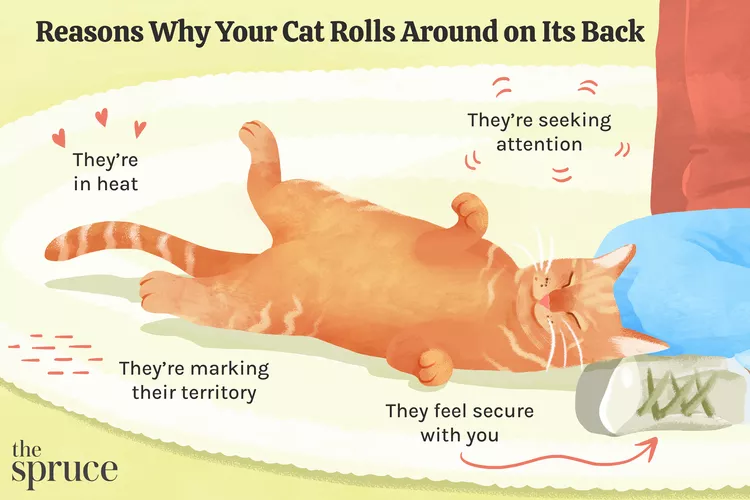Why Your Cat Is Rolling Around on Its Back

Cats roll on their back when they are feeling playful, itchy, or in need of a good stretch. Sometimes the rolling is accompanied by purring, rubbing its head against the floor, and meowing.
No matter the reason why your cat is rolling on its back, this movement is often a positive signal. The rolling-over motion typically means the cat feels safe and maybe wants some attention from you. Here's more about what it could signal.
Safety and Security
A cat doesn't roll over on its back unless it feels safe and secure. In fact, a cat rolls over on its back when it's in its most relaxed state. Think of it as kitty zen mode. If a cat rolls over in front of you, it's a good sign. This is your cat's way of saying, "I trust you." Exposing the belly and/or sensitive parts is a very vulnerable moment for your cat, which is an opportunity for both of you to bond.
Seeking Attention
Consider the timing, location, and circumstances that may have your cat rolling on its back. For instance, if your cat flips over every morning, and right in front of you as you get ready for the day, this is a sign that it wants some attention. Spend some quality time with your cat if you see it rolling on top of its back, your feet, or the floor.
Giving your cat that attention "pays" your kitty for rolling—that's positive reinforcement of the behavior. Thus, your cat will repeat the rolling movement again the next time more attention is wanted. Cats love routine, so once a pattern is established, the rolling becomes a comforting ritual.
Marking Behavior
Rolling on the ground can spread the cat's scent. Because cats primarily communicate through the way someone or something smells, they use the scent glands on their cheeks, paws, and flanks to put a personal scent on stuff. This behavior is seen in both domestic cats and large cats.
When your cat rubs its head and cheeks on the floor, it can be leaving its scent markers on the house and over your feet. This tells other cats that they've been there, claimed their spot, and have already marked you (so other cats need to back off). Marking is used as a way to keep any potential enemies or rivals away.
Many cats feel an instinctive urge to mark their territory through rubbing and scratching. However, if your cat is marking territory with urine, you'll want to teach your cat how to stop.
Mating and Catnip
If you've ever given your cat some catnip, you may have noticed similar rolling behavior. The catnip herb usually incites a strong reaction in cats. Its active compound nepetalactone is a potent scent that triggers a cat's sexual desires. This is what makes them enjoy rolling around on the ground after inhalation.
You'll also find that many female cats roll around and rub against things when they're in heat or after mating. It is likely related to hormones and ovulation. Any frenzied motions may also mean your cat is trying to remove the scent of a male cat before possibly moving on to another male cat.
Not Submissive Like Dogs
Many dogs roll onto their back as a sign of deference or submission, unlike cats. When cats roll over, it usually is more of a solicitation for attention than submission. If you have another animal in the house, like a dog, your cat may do a back roll when the other pet isn't around, so that you know it wants some love.
Never assume your cat is asking for a tummy rub the way dogs do when they roll over. Otherwise, your hand may get grabbed and kicked into submission. Most cats love a scratch behind the ears, so it's best to lead with that instead.
Endless Possibilities
There may be other reasons why your cat is rolling around on the ground. Since cats have a higher body temperature, they'll likely sunbathe or sleep near a heater. Because of this, cats may easily get overwhelmed by the sensation and need to cool down. This includes drinking a lot of water, resting in cool places, and rubbing on cool floors.
Your cat could also be protecting its digestive system by rolling around in the dirt, coating its fur with bacteria, and ingesting it by licking its coat. Whatever your cat is doing, it's probably for a good reason.